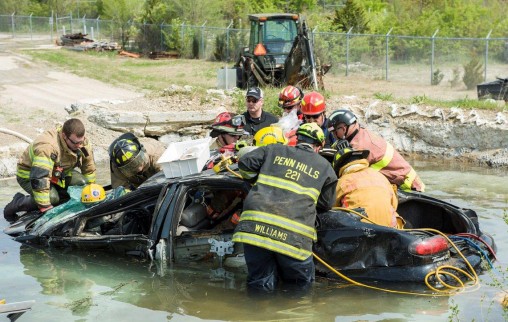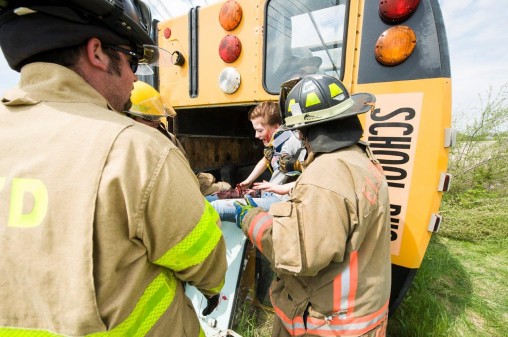
Firefighters practice extricating a victim from a submerged vehicle during the Trauma Care Challenge at Wright State’s National Center for Medical Readiness at Calamityville.
Firefighters clamber over a badly smashed-up car partially submerged in a muddy lagoon. One uses hydraulic rescue equipment to peel back the metal skin and jackhammer his way into the vehicle.
A woman shrieks at the men to rescue her trapped husband before being pulled from the scene and collapsing in grief.
Across the way, firefighters are pulling bloodied students from an overturned school bus. Screams for help come from inside the vehicle.
It was all part of the Trauma Care Challenge, a three-day training exercise at Wright State University’s National Center for Medical Readiness at Calamityville. The exercise attracted firefighters from around the world.
“A lot of training that occurs in our country lacks the realism that allows the first responders to really test their capabilities,” said Deputy Director Jim Gruenberg, co-organizer of the event. “What we’re able to do here is provide them with very unique settings where they can test their skills in very difficult situations.”
The exercise, sponsored by Dayton-based Howell Rescue Systems, ran from May 2 through May 4. The first two days focused on mastering the hydraulic rescue tools, while the final day focused on providing care to high school students and others posing as victims.
The students were from the Warren County Career Center and the sports medicine program at Stebbins High School.
“They get to see the professionals, and a few of them want to become EMTs; just to see it in action and how quickly things need to be done, how to triage, how to do those quick evaluations,” said Ann-Marie Boyce, a teacher at Stebbins who brought some of her students to serve as role players.
Co-organizer Stephanie Davis, associate professor and director of career, technical and adult education at Wright State, said the center and exercises such as the Trauma Care Challenge change lives in the community.
“It’s workforce education and development,” she said.
Calamityville is a 54-acre disaster training zone with concrete passageway-filled buildings, silos, tunnels, ponds, cliffs and wooded areas.
The National Center for Medical Readiness was designed to prepare the civilian and military communities to work with traditional disaster responders and provide the nation with a more complete approach to finding victims, offering initial care and safely evacuating them from disaster-related environments. It has since expanded its mission beyond medical readiness to focus on individual and community-wide readiness, response and recovery from emergencies and disasters.


 Four Wright State nursing programs receive accreditations, including new doctorate degree
Four Wright State nursing programs receive accreditations, including new doctorate degree  Wall Street Journal ranks Wright State top public university in Ohio for student experience
Wall Street Journal ranks Wright State top public university in Ohio for student experience  Wright State’s Raj Soin College of Business to launch Sandler Center for Innovation and Entrepreneurship
Wright State’s Raj Soin College of Business to launch Sandler Center for Innovation and Entrepreneurship  Wright State, Intel partner to integrate AI across Raj Soin College of Business curriculum
Wright State, Intel partner to integrate AI across Raj Soin College of Business curriculum  Wright State English professor to explore literature as handcrafted objects in new book
Wright State English professor to explore literature as handcrafted objects in new book 